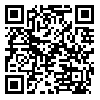Volume 10, Issue 2 (Iranian South Medical Journal 2008)
Iran South Med J 2008, 10(2): 104-111 |
Back to browse issues page
Download citation:
BibTeX | RIS | EndNote | Medlars | ProCite | Reference Manager | RefWorks
Send citation to:



BibTeX | RIS | EndNote | Medlars | ProCite | Reference Manager | RefWorks
Send citation to:
Razmi N, Kolalian Moghadam H, Tabandeh M R, Babakhani A. The therapeutic effect of ingestion of shark cartilage (Carcharhinuss dussumieri) on the growth of Dimethylbenzanthracene induced mammary tumor in Sprague Dawley rat. Iran South Med J 2008; 10 (2) :104-111
URL: http://ismj.bpums.ac.ir/article-1-14-en.html
URL: http://ismj.bpums.ac.ir/article-1-14-en.html
1- , tabandeh@shirazu.ac.ir
Abstract: (20539 Views)
Background: Recently, ingestion of shark cartilage has been increased among patients with cancer on the basis of this claim that sharks rarely develop cancer because of their high proportion of cartilage and antiangiogenesis compounds. The goal of this study was to evaluate the antitumor effect of shark cartilage and growth of induced mammary tumors in rat using dimethylbenzanthracene (DMBA) and to assess the improvement in some Quality-of-Life markers. Methods: Tumors were induced by 7, 12 Dimethylbenzanthracene (DMBA) 20mg/2ml corn oil for each rat using gavage method. Cartilage powder was prepared from neural cord of white snout shark (Persian Gulf, Iran).A total of 60 Sprague Dawley rats were divided in two groups (30 rats in each group): pretumor establishment treatment (PRTE) and post tumor establishment treatment (PSTE). Each group was divided in two control (n=15) and treatment (n=15) subgroups. Animals in treatment PRTE (30 days after tumor induction) and PSTE (after palpable tumors were established) groups were treated with 10mg/day /rat shark cartilage for 30 days. Animal weight gaining, tumor induction time, tumor number and size were recorded on induction and 30, 60, 120 and 200 days after induction. Results: There was no significant difference in number and size of tumors between PSTE treatment and PRTE control, two months after treatment (P>0.05), but this difference was significant between PSTE treatment and PSTE control groups (P<0.05). Weight gaining, in treatment period, was higher in PRTE treatment than PRTE control (P<0.05), but this difference was not significant at the end of the treatment (P>0.05). Two months after treatment tumors significantly regressed in PSTE group. At the end of the study, significant difference was shown between PSTE treatment and other groups in weight gaining, number and size of tumors (P<0.05). Conclusion: Mammary tumor induced with DMBA in rat was regressed when shark cartilage was administrated orally and weight gaining mean, as a marker of improvement of quality of life, was better two months after treatment. But shark cartilage did not prevent tumorigenesis. Further studies about proper dosage, clinical complications, efficient prescription methods and level of availability of biological protein products derived from shark cartilage are recommended.
Type of Study: Original |
Subject:
General
Received: 2006/07/26 | Accepted: 2007/05/30 | Published: 2008/10/8
Received: 2006/07/26 | Accepted: 2007/05/30 | Published: 2008/10/8
Send email to the article author
| Rights and Permissions | |
 |
This work is licensed under a Creative Commons Attribution-NonCommercial 4.0 International License. |





